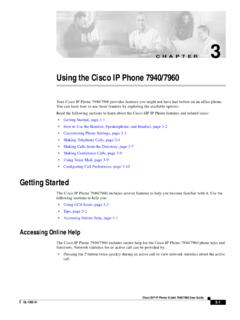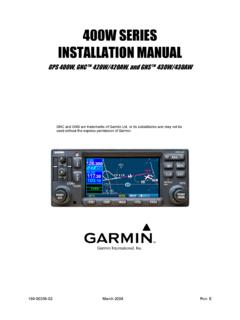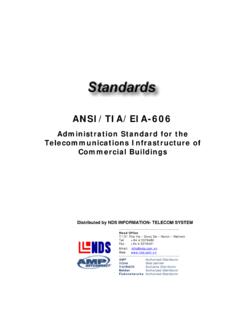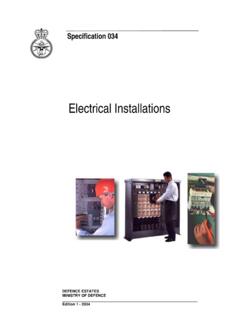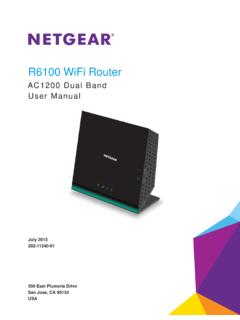Transcription of Telecommunications Standards Manual
1 Telecommunications Standards Manual Page | 0 Telecommunications Standards Manual 8/18/2020 Version Items highlighted in grey have been added / edited from version Table of Contents This document is a guide to all Architects, Engineers, Consultants, and Contractors pertaining to the construction design, review, comments, and approval procedures for Telecommunication and Network services as required by the University of Illinois at Chicago. Telecommunications Standards Manual Page | 1 Table of Contents .. 0 A. OVERVIEW .. 2 B. GENERAL INFORMATION .. 3 C. RESPONSIBILITY AND AUTHORITY .. 4 D. CONSTRUCTION DOCUMENTS & WORKING DRAWINGS .. 7 E. CONTRACTOR REQUIREMENTS FOR BIDDER'S LIST .. 9 F. INSTALLER / TECHNICIAN CERTIFICATION REQUIREMENTS .. 10 G. SCHEDULE .. 11 H. PUNCH LISTS .. 12 I. RECORDS .. 13 J. WARRANTY .. 15 K. CODES, Standards , REGULATIONS AND GUIDELINES .. 16 L. EMERGENCY telephone UNITS (ETUS) AND PARKING ASSISTANCE UNITS (PAUS).
2 17 M. UIC OUTSIDE PLANT DISTRIBUTION SYSTEM .. 30 N. EQUIPMENT ROOMS: IDFs and FDFs .. 38 O. RACEWAYS .. 52 P. GROUNDING AND BONDING .. 67 Q. TRANSMISSION MEDIA .. 74 R. INFORMATION OUTLET INSTALLATION .. 85 S. LABELING / ADMINISTRATION .. 93 T. TESTING .. 101 U. PRODUCTS .. 105 V. WIRELESS ACCESS POINTS .. 113 W. IP VIDEO SURVEILLANCE .. 117 X. HIGH BANDWIDTH TRANSMISSION MEDIA INSTALLATIONS 10/40/100 GIG .. 121 For a complete list of all building Standards for UIC please visit: codes building Standards /building Standards / Telecommunications Standards Manual Page | 2 A. OVERVIEW 1. This document is a guide to all Architects, Engineers, Consultants, and Contractors pertaining to the construction design, review, comments, and approval procedures for Telecommunication and Network services as required by the University of Illinois at Chicago. Deviations will not be permitted without the consent of ACCC/Telecom Engineering Department. The UIC ACCC/Telecom Engineering Department can be reached at 2.
3 The University of Illinois at Chicago leases a CENTREX service from Ameritech for some voice services. Ameritech supplies dial tone to several Nodes on the University property. The dial tone is then delivered to the various campus locations on University owned and maintained copper cable plant. Unified voice services are delivered over the ACCC data network. 3. The University also owns and manages an independent campus fiber optic distribution system that links the various buildings together to provide high speed data service for its users 4. The communications system consists of major elements as follows: a) Dial tone is delivered to Nodes from Ameritech's Monroe Central Office. b) The Nodes are connected by University Cable to all UIC building IDFs (Intermediate Distribution Frames). c) The IDF is connected to all FDFs (Floor Distribution Frames) within the building. d) The FDF is home for each individual Telecommunications INFORMATION OUTLET. e) Network supported services are distributed over campus fiber optics from University Data Centers to each building IDF and FDF.
4 F) The telecommunication outlet has a minimum of two category 6 or 6a data jacks. (1) For locations with Centrex or analog required services the addition of a voice jack may be required. (2) Any changes to the standard Telecommunications outlet must be approved by the ACCC/Telecom Engineering Department 5. All new or remodeled buildings must include both copper cable and fiber optic distribution systems extended to each FDF to properly serve the buildings. 6. These Standards are provided to maintain adequate communications facilities in the University Buildings. Communication facilities include the cable distribution plant and cable termination equipment, both copper and fiber. 7. The Project Manager shall abide by these Standards and allow no deviations without the consent of the ACCC/Telecom Engineering Department. All consultants shall incorporate this information into the design for all University projects. Telecommunications Standards Manual Page | 3 B. GENERAL INFORMATION 1.
5 The University's communications systems are complex. The systems that comprise the overall network enable the University to conduct its business. They include a variety of architectures and operate over numerous types of media. For questions contact the UIC ACCC/Telecom Engineering Department at 2. This standard specifies minimum requirements for Telecommunications wiring between and within University buildings at the University of Illinois at Chicago. 3. This standard specifies a media system with a definite topology and specifies allowable distances between system components. The parameters of this media will determine performance, specific connectors and pin assignments to ensure interconnect ability. 4. Although the scope is limited only to the Telecommunications aspect of building design, it should be recognized that this standard highly influences the design of other building systems and services; it also impacts space allocation within the building. 5. The term Telecommunications as it relates to this standard encompasses all forms of information transport and processing.
6 These will include voice, data, video, security, safety and any other Telecommunications ingredients of a modern building. Telecommunications Standards Manual Page | 4 C. RESPONSIBILITY AND AUTHORITY 1. UIC Telecommunications DEPARTMENT a) The Telecommunications Department at the University of Illinois at Chicago will have the final review, approval, and acceptance authority for all Telecommunications systems, facilities, and material. Consulting and coordination assistance is provided by the UIC ACCC/Telecom Engineering Department. For questions contact the UIC ACCC/Telecom Engineering Department at 2. CONSULTING Telecommunications ENGINEER a) New construction, major remodeling and renovation projects will require the services of a Consulting Telecommunications Engineer. This engineer will be employed the same as a Structural, Mechanical, or other types of Engineers. UIC ACCC/Telecom Engineering Department is to be consulted relative to the need for a Telecommunications Engineer on all projects.
7 B) Minimum qualifications for a Telecommunications Engineer are as follows: (1) A Registered Communications Distribution Designer (RCDD) shall be employed within the company. The RCDD shall affix their stamp to the bid document and all subsequent changes to the design. (2) Ten years of working experience in the Telecommunications industry and three years working experience in the planning and design of outside plant (OSP) and building riser facilities. (3) Ability to author detailed specifications, construction drawings, bid documents, test requirements, and other documents. (4) Ability to prepare punch lists and as built drawings. (5) Ability to inspect and supervise projects. (6) Ability to chair progress meetings and resolve differences. (7) Experience in a campus environment. (8) Knowledge of Bell System Practices (BSPs) for outside plant engineering. (9) Two years of experience working with category 6 / 6A cable and fiber optic media facilities. (10) Must have the ability to apply design practices in accordance to the latest BICSI TDMM c) The commissioned Project Architect/Engineer is responsible for developing adequate space within the building for telecommunication facilities.
8 This will include the conduits, cable raceways, enclosures, and the FDF wiring rooms (FDFs / IDFs / NODEs). d) The Project Architect/Engineer is responsible for the detail design of all Telecommunications facilities required in the building. It should be noted that unless there is a separate utility project associated, the project Architect/Engineer is also responsible for the extension of the University outside plant facilities from a specific Node to the specified building. The UIC ACCC/Telecom Engineering Department will help in the planning process of the project. Telecommunications Standards Manual Page | 5 3. Telecommunications CONTRACTORS a) Minimum qualifications for Telecommunications Contractors are: (1) Five years of experience in the Telecommunications industry. (2) Contractors must have BICSI technicians that have at least two years of experience and the ability to install, test and troubleshoot structured cabling systems including multimode and single mode optical cable plants.
9 These cable plants include intra building and inter building cabling . At least one Technician must be certified for crews of 4 or fewer. For every four or less additional techs, one of the four must hold the Technician certification. (3) Three years working experience in outside plant construction and building cable installation. (4) Experience in installing backbone and distribution cables. (5) Experience in a campus environment. (6) Ability to read and interpret construction drawings and specifications. (7) Experience with Northern Telecom Gibabix Cross Connect Systems and/ or 110 blocks. (8) Ability to terminate the station jacks and all connecting blocks according to Industry and UIC Telecommunications specifications. Technicians must have at least two years of experience. (9) Ability to test and record the results for all copper and fiber cable that is installed as well as the associated hardware, according to UIC ACCC/Telecom Engineering Department Specifications. (10) Ability to terminate, splice and certify Fiber Optic Systems.
10 (11) Ability to terminate and certify gig / 10 gig copper cabling . (12) Ability to produce cable and other record drawings. (13) Have the necessary test equipment and trained technicians to operate the equipment. b) The reliance on sub contractors will be limited on University projects and the level of reliance will be part of the evaluation criteria. c) The Telecommunications Contractor shall: (1) Provide all material that is not specifically identified as University provided. (2) Provide material that is new and free from defects, delivered to the job site in the original packing. d) All material, equipment, and devices shall be handled and installed in a manner according to the manufacturer's specifications and consistent with industry Standards , UIC ACCC/Telecom Engineering Department Building Standards , and all local and national codes. Any deviations from the manufacturer's recommendations shall be reviewed and approved by UIC ACCC/Telecom Engineering Department prior to installation.
